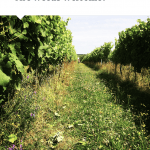The secret life of nitrogen
‘The secret life of nitrogen’. Vinescape’s Viticulturist, Frances Trappey, shares her words of wisdom in this article published in the May 2022 issue of Vineyard Magazine.
Vines may have a reputation for having low nutrient demands, particularly for nitrogen, but ignoring their requirements can result in deficiencies, poor growth, and lower yields. Nitrogen levels in grape composition can impact the must – affecting fermentation and wine flavour profile. Nitrogen has a reputation for being complicated to measure with unpredictable plant-availability. Jo Cowderoy finds out from some of the experts how to demystify nitrogen in vines.
The vine’s needs for nitrogen
In vines, nutrients are generally taken up by the roots from the soil. Calculating how much the vines need, and when, measuring what is in the soil, and ascertaining availability can be challenging – especially with nitrogen.
Managing nitrogen in the vineyard is complex. The aim is to control vigour, while optimising yield and grape composition – as well as being mindful of production costs and pollutants. Nitrogen fertilisation has been common in the past but uptake is reportedly inefficient, and manufactured nitrogen fertilisers come with increasing price tags.
Vines are considered to have a low, or moderate, requirement for nitrogen, but they are still subject to Liebig’s Law of the Minimum – which states ‘yield is proportional to the amount of the most limiting nutrient.’ The textbook ‘barrel’ image shows that if, for example, nitrogen is in short supply, even if the other nutrients are abundant, yield will be limited.
“To all intents and purposes, you can assume vineyard available soil nitrogen (N) level in the UK is virtually zero at bud-break, in all but the mildest and driest winters,” explained Mark Botting, Chartered Chemist and Laboratory Manager at Fruit Advisory Services Team LLP.
“The crop requirement in a UK vineyard is in the region of 35kg/ha to 75Kg/ha depending on vine age and yield potential. A good mineral clay loam soil in the UK can mineralise up to 40Kg/ha of N per year in the typical root zone depth – sandy soils and shallow soils over chalk will produce less and organic ‘peaty’ soils considerably more.
“Therefore, the grower’s own knowledge of soil type and organic matter level will help estimate how much N will be mineralised during each growing season, along with knowledge of the growth habit – especially vigour – and the yield potential on a block by block and variety by variety basis,” Mark added.
“At Rathfinny Estate, we estimate nitrogen requirements based on the previous season’s harvest and how much N we removed in the fruit,” commented Cameron Roucher, Vineyard Manager, Rathfinny.
“I record yield from each block to determine how much nitrogen was removed at harvest,” explained Frances Trappey, FACTS qualified Viticulturist at Vinescapes. “I also use petiole analysis from a representative sample of vines within each block to provide an accurate snapshot of the current vine nitrogen status.
“The DEFRA fertiliser manual, RB209, is relevant for vines and for good soil management in general. However, it is only a guide and regular soil sampling (the standard is every three years) and petiole analysis (annual/biannual) should be carried out to provide the most accurate snapshot of what is going on in the vineyard – both above and below ground,” added Frances.
“For the first year or two after planting, there may not be a need to apply nitrogen,” advised Mark, “but as yields increase in young vines supplemental N by incorporating organic materials or from manufactured nitrogen fertiliser is likely to be required to aid crop establishment. Beyond that age, mature vines are able to retain higher quantities of N in their roots and trunk, so applications of fertiliser are less critical – but are still important to maintain good crop health and yields. If you are adding nitrogen based on a crop requirement of 60Kg/ha and think that your soil can mineralise 35Kg/ha an extra 25Kg/ha is needed. However, not all of the applied N is taken up by the crop. At best in a clay loam soil at a pH of 6.5 the N fertiliser efficiency can be only 80%, but on shallow soils over chalk it can be as low as 55% meaning that to get 25Kg/ha of N in the crop you need to apply 30kg/ha and 45Kg/ha N respectively.
“All the below-ground processes that mineralise nitrogen are driven primarily by bacterial and fungal action as soil temperature rises after winter. There are, of course, times when demand exceeds supply which is why spring N fertilizer applications are made in order to support vegetative growth, to feed the growing crop, and equally important but hidden from view, to feed the forming inflorescences that will be next year’s fruiting buds,” continued Mark.
“About 99% of soil nitrogen is in an organic form and therefore not directly available to the vine without healthy soil biology. The available forms of nitrogen are produced through mineralization by microorganisms. Compost not only helps supply nutrients but increases soil organic carbon which is a good way to improve the nutrient availability in soils,” added Cameron.
Measuring nitrogen
“Available nitrogen in the soil is difficult to measure accurately, as this can change throughout the year,” explained Frances. “Instead, I will use petiole analysis at bloom and veraison and I will also keep accurate records of yield per block and monitor soil organic matter in the vineyard. Additionally, I regularly scout for signs of nutritional deficiency throughout the season,” Frances added.
“Good mineral soils, in drier conditions, will warm up quicker in the spring so N will become available earlier than in cooler, wetter soils. Some growers may not need to apply early N; it is best to have ‘eyes on the ground’ and observe the vineyard,” commented Mark.
Soil analysis for nitrogen, and its availability, is a bit complicated,” explained Julian Searle, Agronomist at Agrii. “Dissolved nitrogen as nitrate is an anion, so negatively charged, and not held by the soil inorganic matter (clays) like the positively charged cations, such as potassium, calcium, and magnesium. More practically, growers tend to assess availability and requirement, in woody crops, from the canopy vigour and manage input – required, or not, accordingly. This could be: apply none, a little, or more – depending on crop set after flowering to support and promote yield,” Julian added.
“Petiole sap analysis at bloom and at veraison is a good management practice to determine plant nitrogen status, as is leaf blade analysis at an early vegetive stage – at bloom and veraison are just as effective. Research from Oregon in 2017 on Pinot Noir showed that both petiole and leaf blade analysis were equally effective in determining plant nitrogen status, but leaf blade analysis came out on top for predicting nitrogen, phosphorous and potassium requirements. The results of laboratory analysis of sap or leaf blade nitrogen need to be considered alongside a visual inspection of the vigour of each block within a vineyard when planning nitrogen applications,” explained Mark.
“The main factors affecting nitrogen availability in soils are temperature and organic matter content. The higher both are, the more mineralised nitrogen is likely be available. The textbook nitrogen cycle chart is useful for visualising the process,” added Mark.
Nitrogen additions and timing
“Yara publish a graph that shows suggested grape demand over the season,” commented Julian. “Typical timings are a split dose of ground nitrogen – half applied a month before flowering, possibly another post-flowering depending on set. There is evidence in top fruit that nitrogen applied as calcium nitrate pre harvest, or just post, is also beneficial to build over wintering carbohydrate reserves and to feed possible dormant season respiration loss in warmer climates.
“It’s also quite common to apply foliar nitrogen pre flowering to assist pollen tube growth and perhaps a post flowering boost where yield looks high and ‘bony’ canopies look to be struggling. Nitrogen additions at veraison can also help provide yeast available nitrogen (YAN) for fermentation,” added Julian.
“If you calculate that an annual application of an additional 40Kg/ha N (over and above what is likely to be mineralised by the soil) is required, I would recommend applying 20Kg/ha N adjusted for the fertiliser uptake efficiency described previously in spring and the other 20Kg/ha N immediately post-harvest when soil temperatures are still high enough that root nutrient uptake is still taking place to build reserves in the roots and trunk,” said Mark.
“The timing of additions is always dependant on the season, weather, and growth stage of the vine, and if we are within the NVZ application period,” explained Cameron Roucher. “It is usually good to apply nitrogen about a month after bud burst and just after fruit set to correspond with demand from developing fruit. But this all depends on soil temperature and moisture levels. At Rathfinny we are within an NVZ and therefore are not able to apply post harvest – and in any case finding a window to apply at that time of year is difficult and there is a high risk of leaching due to rainfall. If this wasn’t the case a post harvest application could be beneficial.
“We use composts, seaweed, and some manufactured nitrogen – but we are slowly weaning off any artificial nitrogen. We also use foliar applications of nitrogen in very small doses and as a supplement, as I find this is an easy way to tweak canopy growth throughout the season – although macro nutrients are difficult to apply by foliar,” Cameron added.
“A vine’s main requirement of nitrogen is in early spring to fuel shoot growth however, most of this is driven by carbohydrates stored after harvest,” explained Frances Trappey. “So, monitoring phenological stages is crucial as this will determine when nitrogen is required – with the most required between bloom and fruit set as well as veraison.
“Between post-harvest and leaf fall the application of nitrogen will benefit the vines last flush of root growth and storage of carbohydrate before dormancy. Nitrogen reserves stored as carbohydrates in the vine will fuel early spring growth, so post-harvest nitrogen management is incredibly important. However, be mindful of the closed periods for soil application and that nitrogen applied too late can delay dormancy ultimately making the vines less cold hardy and prone to winter damage.
“The source of nitrogen for additions really depends on the circumstance as there are a lot of factors to consider. Application of manufactured nitrogen is not my preferred source because it is expensive, easily leached and if it is applied under the wrong conditions or timing it can have harmful effects on the environment. For example, application to waterlogged soils can cause reduction of nitrate to nitrous oxide which is 300 times more potent than carbon dioxide as a greenhouse gas! I will apply manufactured nitrogen if absolutely necessary to support the immediate need of the vines – determined by petiole analysis and nutritional scouting in the vineyard – and if their productivity or health is at stake.
“Plant available nitrogen is in the form of nitrate and ammonium and is converted from organic nitrogen in the soil. This is a microbial process which is dependent on temperature, aeration, and moisture content – compacted, cold, or waterlogged soils will limit the conversion of organic nitrogen into plant available nitrogen. Therefore, my focus is mainly on maintaining good soil structure, biology, pH, and adequate levels of soil organic matter between 2-4% and including other organic sources of nitrogen as foliar spray, such as seaweed. pH is important as nitrogen becomes less available to the vines below 6.0 and above 8.0,” added Frances.
C:N ratios
The carbon-to-nitrogen ratio is the mass of carbon to the mass of nitrogen in the soil.
The ratio is significant as it can affect plant residue decomposition and nutrient cycling. “The ideal carbon to nitrogen ratio in soil and composts is said to be 25-30:1,” explained Julian Searle. “The trend is to use organic based nitrogen fertilisers as they are slow release, good for a perennial fruit crop, and they also build soil organic matter and humic content – which stores nutrients and the soil biota that mineralises it. Having a high ratio, that is too much carbon, will lock up nitrogen and having too little, or a low ratio, then nitrogen is lost to the atmosphere and by leaching,” said Julian.
Cover crops
“For solid environmental and cost reasons, growers should be looking to increase the use of organic forms of nitrogen over manufactured nitrogen fertilisers,” commented Mark. “I suspect that in the coming years the spreading of organic waste materials from digestate plants and the like will become more commonplace in vineyard nitrogen application regimes as suitable application machinery that can manoeuvre in rowed crops like grapevines becomes available.
“A winter legume such as vetch or clover as a cover crop can be a good N source. Other incorporated cover crops whose main aim is to avoid a bare soil surface over winter or to improve soil structure will also be a good source of N,” Mark added.
Sam Lane, Technical Manager, Cotswolds Seeds Ltd, supplies seed mixes for vineyard cover crops. “When considering cover crop seed mixtures, we establish what the mix is trying to achieve, how long it will be in the ground for; permanent, three years or six months – as some plant species have a longer life span than others – and what sort of soil type and environment the cover crop will be grown in. We also consider if species will become a problem in certain situations, such as going to seed and potentially becoming a weed issue or growing too tall and bulky and suppressing or smothering existing plants.
“Broadly speaking, cover crop plant species can be broken down into those that fix nitrogen (legumes) and those that scavenge and hold any available nitrogen in the soil. Legumes fix atmospheric nitrogen from the air by creating an association with atmospheric nitrogen and rhizobium in the plant root nodules, converting the nitrogen to allow it to be utilised for plant growth.
“However, legumes will only ‘fix’ nitrogen in warm soils, when soil temp is a consistent seven degrees, usually from late April to October – it is a myth that they will fix nitrogen over the winter when the soils are cold! As you would expect legumes, such as clover, vetch and trefoils to have a high nitrogen ration, fixing nitrogen in warm conditions for themselves and boosting the plants around them and then releasing a quick burst of nitrogen when they are either grazed, cut or terminated and mulched in.
“Other cover crop species such as cereals, warm season grasses like millets and sorghums or brassicas that are allowed to become mature and woody tend to have a much higher carbon ratio, meaning they release any nitrogen scavenged and built up within the plant as it breaks down over a longer period.
“When considering a cover crop to boost nitrogen availability, one option is to plant a high legume mixture prior to setting up a vineyard. This could be based around a two year or three year cover crop of perennial clovers like red clover and alsike clover, to be terminated and incorporated just before new vines are planted. Alternatively, if there is a more immediate time pressure, fast growing annual legume species can be sown for a short burst nitrogen fix, such as crimson clover, persian clover, berseem clover, or vetch – these species will fix around 100-150kg of nitrogen per hectare during warm spring and summer conditions over three to five months.
“Some growers will find that low growing, prostrate nitrogen fixing species, such as small leaf white clover and/or yellow trefoil planted immediately beneath the vines, act as a nitrogen fixing companion crop over several years. The low growth habit ensures they do not compete or disrupt the growth of the vines above.
“On high fertility sites a short term, high biomass hungry species can be planted to scavenge as much residual nitrogen from the soil, such as quick growing three-to-four-month brassica species like mustard or a fast-growing annual ryegrass. Ideally these cover crops should be cut and removed from the site and composted or utilised elsewhere to lower the fertility levels in the soil. Again, this is normally done prior to setting up the vineyard. If a vineyard is already in place, repeatedly mowing and removing the vegetation between the vines will also lower the soil fertility,” Sam added.
At Rathfinny we have been experimenting with various seed mixes for cover crops and are trying to find the holy grail for not having to apply fertiliser at all! By using cover crops to fix nitrogen from the atmosphere, and then protecting the soil biology, we aim to get to a position where we don’t have to apply fertiliser in any form,” said Cameron Roucher.
The regulations
“There are lots of rules which stipulate when and how much nitrogen you can apply to your land,” explained Frances Trappey. “Soil applications of manufactured nitrogen and organic manures are limited to the open periods only, unless you have received written advice from a FACTS qualified advisor. You should also follow the Code of Good Agricultural Practice which stipulates the conditions you should not spread nitrogen fertilisers on land. For example, because nitrate is easily leached through the soil, this should not be spread when heavy rain is forecasted within the next 48 hours. You should also be aware if your vineyard is in a Nitrate Vulnerable Zone (NVZ) as this will further dictate how and when you can apply N to your land,” said Frances.
“If I understand the recent Farming Rules for Water (England) correctly, for those growers not in NVZ’s land managers should have a nutrient management plan in place based on ADAS Nutrient Management Guide (RB209) tables or similar app-based calculators or created by a FACTS qualified advisor. The plan should take account of plant tissue analysis, soil analysis, and the nutrient content of manures and fertilisers applied,” added Mark.
Nitrogen for fermentation
Beyond the vineyard, an understanding of the grapevine nitrogen status, and ultimately must composition, is important for high-quality grape production. “Application of nitrogen in the vineyard, be it foliar or soil applied, will increase both FAN (free available nitrogen) and YAN (yeast available nitrogen- which is amino acid nitrogen plus FAN),” explained David Cowderoy, Consultant Winemaker and BevTech Ltd Managing Director. “The increase, and balance between FAN and YAN is hard to predict as it is influenced by many other factors. From a wine quality perspective sufficient levels of FAN are essential for yeast growth early on during fermentation. However, excessive levels can give rise to rapid yeast multiplication and then competition for nutrients later during fermentation – and potential metabolic uncoupling leading to reduction and stuck ferments. Conversely high levels of amino acid nitrogen will increase biosynthesis of flavour compounds.
“Nitrogen additions in the vineyard will affect grape composition, but in my view, trying to manipulate must nitrogen levels by vineyard additions is a very blunt instrument and risks errors. It is far better to measure must FAN and YAN and then make winery additions according to the vinification protocol and above all the requirements of the chosen yeast strain,” added David.
Conclusion
“As with all soil nutrients, nitrogen management goes beyond just looking at the numbers in a given year. Nitrogen management is looking at the whole farming system above and below ground, being precise about your applications, planning and developing a long-term vineyard management plan that should be compliant with legislation and mindful of your community. Because both organic and manufactured forms of nitrogen fertilisers can be polluting to water and air, we should all be doing our part to protect these resources for our communities, and ecosystems (human and otherwise!),” concluded Frances Trappey.






